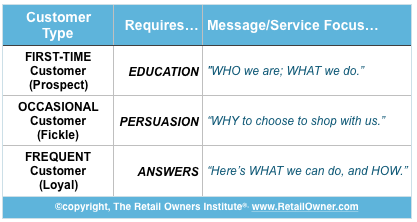How to Customize Your Customer Service
by Patricia M. Johnson, CMC and Richard F. Outcalt, CMC 
Most specialty retailers are quick to claim that they provide outstanding customer service. Indeed, for many shoppers, customer service is what sets apart the specialty retailer from the big-box stores or discounters.
But think for a moment about the person on the receiving end of this “good customer service”. Yes, we mean your shopper. What constitutes “good customer service” for her?
Consider this. Many retailers we know are terrific “people people.” Instinctively, it seems, they adapt their own personal customer service to each shopper they deal with.
- With some customers, they carefully explain the subtleties of recognizing high quality in the product.
- With other customers, they are quick to offer an array of choices.
- For yet others, they dispense with small talk and “cut to the chase.”
These merchants understand that good customer service does not result from a one-size-fits-all approach. They know the answer to “What constitutes good customer service?” is, “That depends!”
The Institute has developed a tool to help you sort your customers informally into one of three groups, based on their Customer Type. This enables you to truly customize your customer service!
These three groups are:
- Frequent Customers (Loyal)
- Occasional Customers (Fickle)
- First-Time Customers (New!)
Importantly, the Customer Type is driven by their actual purchasing behaviors with you. Each customer type has its own distinctive requirements for service from you.

Let’s review each of these customer types and what their different customer service requirements might mean in your store.
Frequent Customers - The Loyal Ones
Frequent Customers are the most experienced and knowledgeable shoppers, and often are your most loyal customers. What they need is answers, just the facts. What hours are you open? Do you have this item in stock? What is the price? Where do I pay?
They want specific information delivered in a straight-forward manner.
Consider conveying information with “shelf talkers,” which are factual signs posted on the shelf with the product.
Or, consider placing computer terminals in kiosks in your store, with more detailed product information readily available. (Many of them are especially drawn to self-service features like this that they can control.)
For these customers, it is essential the merchandise in your store is organized so they can quickly and easily find what they are looking for. They want to be able to walk in and immediately narrow down their search to perhaps a couple of shelves. Similarly, “price and item” advertising can be very useful to these shoppers.
Remember, they want the facts; they want information.
Occasional Customers - The Fickle Ones
Occasional Customers are familiar with your store, but they need to be persuaded to buy from you rather than someone else.
What benefits do you provide that others cannot?
Here is your opportunity to emphasize the special lines that you carry. Displays from manufacturers are also convenient ways to convey these persuasive messages to your customers.
If your store prefers a particular brand, or sells a particular brand more frequently, you may choose to subtly pass this preference along to your customers by featuring a certain manufacturer’s signage.
Similarly, any special financing programs you offer should be featured. Or, perhaps your sales staff has significant experience, or you have a service department staffed with people with specialized training and certification.
Think of all the qualities of your store that set you apart from your competitors. Here is where “institutional advertising” can be beneficial. Marshall those messages to help capture those Occasional Buyers (and to reinforce the decision of your Frequent Buyers to be such loyal customers!)
First Time Customers - The New Ones!
First-Time Buyers (you're right; that's a euphemism for current "Non-Customers") have no idea what to expect when they walk into your store or visit your website.
They are not very familiar with your products, may feel intimidated, and certainly will benefit from a staff member who will take the time to discuss their options.
What these customers need is education about your products – and your store. They also need help in comparing and contrasting products and deciding what is best for them.
These shoppers often are drawn to “objective” product reviews, or even reprints from newspapers or magazines that provide overviews of your products. And they may rely on your staff to edit their choices for them.
Here is your opportunity to put together “package solutions” for your customer, such as “Good”, “Better”, “Best” choices.
A knowledgeable staff member can provide this general introduction. Once the customer has made some basic decisions about the kind of products they need, shelf talkers or other displays can help persuade their final decision.
Keep in mind first-time buyers will likely assume your store trusts and recommends the items accompanied by a particular manufacturer’s signage.
Study Their Habits
Analyzing your shoppers and sorting them into these three Customer Types need not be a formal or expensive project.
In fact, some retailers we know give personal names to each customer type – Chris for the Frequent Shopper, Susie for the Occasional Shopper, and Charlie for the First-Timer.
They even develop brief stories about each of these shoppers (where they live, what cars they drive, what pets they own, etc.) Having a personality in mind helps to match up advertising, merchandising and sales programs for each customer type.
Of course, not every customer fits neatly into one of our three Customer Type categories. But, those exceptions should not prevent you from enjoying the gains in productivity and efficiency of matching your customer service to your customer requirements.
Once and for all, it’s time to step away from the one-size-fits-all approach to customer service. You – and your customers! – will be glad you did.
©Copyright, The Retail Owners Institute® and Outcalt & Johnson: Retail Strategists, LLC.